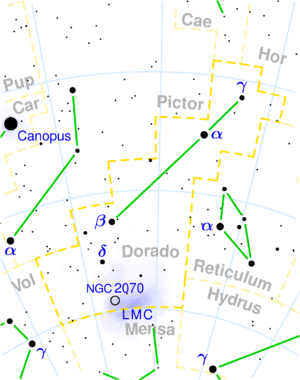|
|
Dorado ( Spanish: mahi-mahi or dolphin-fish) is a southern constellation. The constellation was one of twelve constellations created by Pieter Dirkszoon Keyser and Frederick de Houtman between 1595 and 1597, and it first appeared in Johann Bayer's Uranometria of 1603. It is also known as Xiphias or the Sword-fish. The name Dorado is not really a Latin word, but it is treated like a feminine proper name of Greek origin whose nominative singular ends in -o (like Io or Callisto) and whose genitive ends in -us. Dorado is notable for containing most of the Large Magellanic Cloud, the remainder being in the constellation Mensa. The South Ecliptic Pole also lies within this constellation. Notable stars * S Dor 9.721 – hypergiant in the Large Magellanic Cloud, S Dor variable prototype * Supernova 1987A is the closest supernova since the invention of the telescope. * The variable star R Doradus 5.73 – has the largest known size of any star.[1] * HE 0437-5439, a hypervelocity star escaping from the Milky Way/Magellanic Cloud system * γ Dor, prototype of the γ Dor variable stars * See also the list of stars in Dorado Notable deep sky objects Because Dorado contains part of the Large Magellanic Cloud, it is rich in deep sky objects. All coordinates given are for Epoch J2000.0. * NGC 1566 (RA 04h 20m 00s Dec -56° 56.3′) Skyview image is a face-on spiral galaxy. It gives its name to the NGC 1566 group of galaxies. * NGC 1755 (RA 04h 55m 13s Dec -68° 12.2′) Skyview image is a globular cluster. * NGC 1763 (RA 04h 56m 49s Dec -68° 24.5′) Skyview image is a bright nebula associated with three type B stars. * NGC 1820 (RA 05h 04m 02s Dec -67° 15.9′) Skyview image is an open cluster. * NGC 1850 (RA 05h 08m 44s Dec -68° 45.7′) Skyview image is a globular cluster. * NGC 1854 (RA 05h 09m 19s Dec -68° 50.8′) Skyview image is a globular cluster. * NGC 1869 (RA 05h 13m 56s Dec -67° 22.8′) Skyview image is an open cluster. * NGC 1901 (RA 05h 18m 15s Dec -68° 26.2′) Skyview image is an open cluster. * NGC 1910 (RA 05h 18m 43s Dec -69° 13.9′) Skyview image is an open cluster. * NGC 1936 (RA 05h 22m 14s Dec -67° 58.7′) Skyview image is a bright nebula and is one of four NGC objects in close proximity, the others being NGC 1929, NGC 1934 and NGC 1935. * NGC 1978 (RA 05h 28m 36s Dec -66° 14.0′) Skyview image is an open cluster. * NGC 2002 (RA 05h 30m 17s Dec -66° 53.1′) Skyview image is an open cluster. * NGC 2027 (RA 05h 35m 00s Dec -66° 55.0′) Skyview image is an open cluster. * NGC 2032 (RA 05h 35m 21s Dec -67° 34.1′) (Seagull Nebula) Skyview image is a nebula complex that contains four separate NGC designations: NGC 2029, NGC 2032, NGC 2035 and NGC 2040. * NGC 2070 (RA 05h 38m 37s Dec -69° 05.7′) is better known as the Tarantula Nebula. * NGC 2164 (RA 05h 58m 53s Dec -68° 30.9′) Skyview image is a globular cluster. References * The above deep sky objects appear in Norton's Star Atlas, 1973 edition. * Co-ordinates are obtained from Uranometria Chart Index and Skyview. * Images of the deep sky objects described herein may be viewed at Skyview. * Ian Ridpath and Wil Tirion (2007). Stars and Planets Guide Links
Retrieved from "http://en.wikipedia.org/"
|
|
||||||||||||||||||||||||||||||||||||||||||||||||||||
